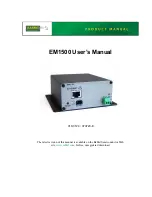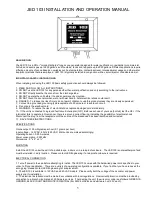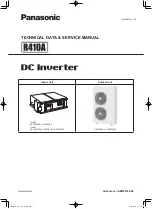1.0 Introduction
The board inputs are provided at BNC1 and BNC2.
Jumper headers JP1 and JP3 allow these inputs to be
either a.c. or d.c. coupled to the DUT. Provision is made
to adjust the DUT supply voltage (measured at TP1) with
potentiometer VR1.
These ADC Design Kits (consisting of one of these
evaluation
boards:
ADC12xS101,
ADC10xS101,
ADC08xS101,
ADC12xS051,
ADC10xS051,
ADC08xS051,
ADC12xS021,
ADC10xS021,
ADC08xS021 and WaveVision4 hardware, where "x" in
the device types here could be a 2 or a 4, indicating the
number of multiplexer inputs) is designed to ease
evaluation
and
design-in
of
these
National
Semiconductor Analog-to-Digital Converters. These
evaluation boards allow the desivgner to evaluate product
performance in a choice of two ways: in standalone mode
with a logic analyzer and appropriate software (including
National's WaveVision software), or with a personal
computer and
WaveVision4
hardware and software.
VR2 is used to set the input offset.
2.0 Board Assembly
These Evaluation Boards come fully assembled and
ready to use. Refer to the Bill of Materials for a
description of components, to
Figure 1
for major
component placement and to
Figure 2
for the Evaluation
Board schematic.
3.0 Quick Start
Refer to
Figure 1
for locations of test points and major
components.
Reference in this Guide to DUT is meant to refer to the
particular device for which you have the evaluation board.
1.
Connect the evaluation board to the Capture Board
(order number WAVEVSN BRD 4.0). See the
Capture Board Manual for operation of that board.
For operation with a computer system, this evaluation
board should be coupled to a WaveVision4 data capture
board (National part number WAVEVSN BRD 4.0) using
the WaveVision software operating under Microsoft
Windows. The analog signal presented to the DUT is
captured by the WaveVision4 data capture board, and
displayed on the computer screen as a dynamic
waveform, FFT, and/or histogram. The software also
computes and displays dynamic performance in the form
of SNR, SINAD, THD, SFDR, and ENOB.
2.
Connect a clean power supply to the terminals of
connector P1. Adjust power supply to a voltage of
±5.5V to ±5.7V before connecting it to the board.
3.
Connect a voltmeter to TP1 and use VR1 to set the
DUT analog supply voltage for the desired value
b2.7V and +5.0V.
4.
Set the jumper to short pins 1 and 2 of JP6 and be
sure there is a clock oscillator of the appropriate
frequency at Y1.
Important Note:
The evaluation boards for all of these ADCs
look identical. The actual device placed on your evaluation
board can be identified by the label on the board and verified
by looking at the DUT (Device Under Test) top mark. The
devices have the following top marks:
5.
Put a jumper between pins 1 and 2 of JP1 and pins
1 and 2 of JP2.
6.
Connect a signal, through an appropriate bandpass
filter, to BNC1. The peak-to-peak amplitude of this
signal at TP6 should be the same as or just under
the power supply voltage setting.
Device
Top Mark
ADC082S101
X22C
ADC082S051
X04C
ADC082S021
X16C
7.
Connect a USB cable between the WaveVision
Capture Board and the PC.
ADC084S101
X25C
ADC084S051
X10C
8.
Run the WaveVision 4 software and click on
Settings, then click on Capture. Under "Board Type"
select "WaveVision 4.0 (USB)".
ADC084S021
X19C
ADC102S101
X23C
ADC102S051
X05C
9.
Under "Communication" press the "Test" button. If
you get a "Communication Failed" message, check
all connections and be sure the power supply is on.
ADC102S021
X17C
ADC104S101
X26C
10. If the appropriate sample rate (not clock rate) is not
reported, check to be sure the clock signal has
adequate amplitude and repeat the previous step.
ADC104S051
X11C
ADC104S021
X20C
ADC122S101
X24C
11. Click "Accept" then gather data by pressing F1 on
the keyboard. Perform an FFT on the data by
clicking on the FFT tab.
ADC122S051
X06C
ADC122S021
X18C
ADC124S101
X27C
ADC124S051
X12C
See the WaveVision Capture Board Manual for complete
data gathering instructions.
ADC124S021
X21C
The signal at the Analog Input to the board is digitized
and is available at FutureBus connector J2.
3
http://www.national.com


















